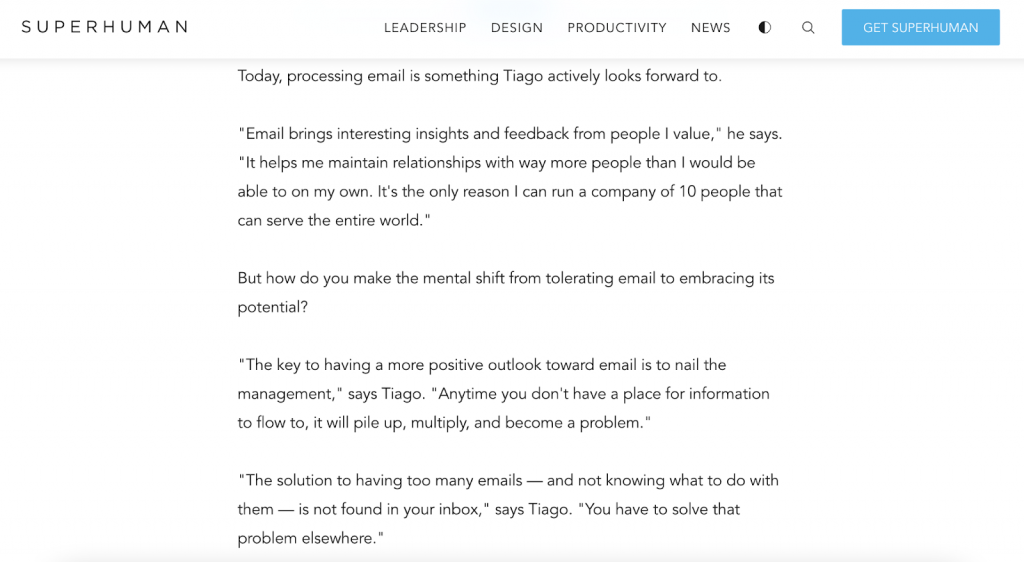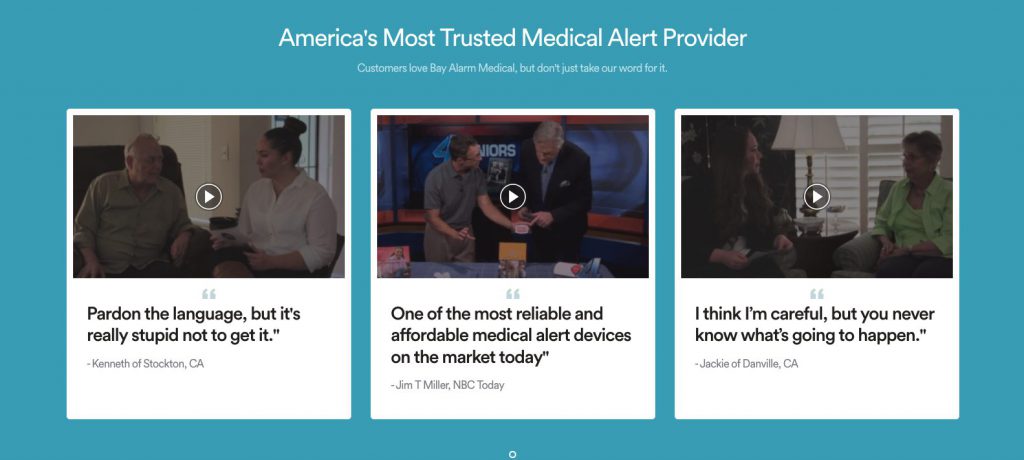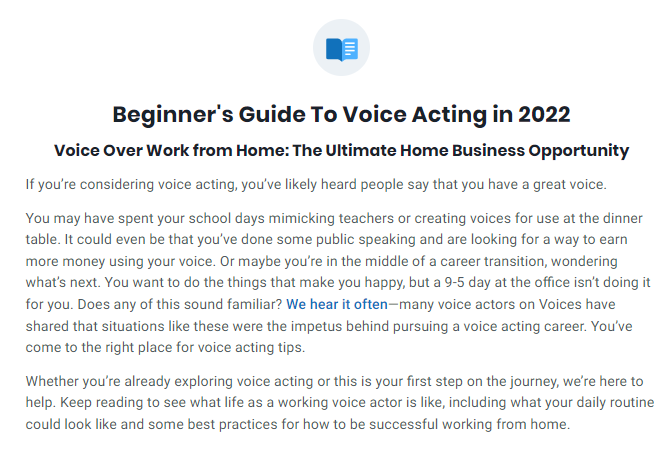Creating and publishing next-level content is one of the best ways to invest in your brand. And, if you take a glance at people’s internet usage habits, you’ll find out just why.
In 2021, the average person spent 6 hours and 58 minutes online. During those (almost) seven hours,
- 61% of people primarily went online to find and consume information.
- 53.1% kept up-to-date with news and events.
- 51.5% watched videos.
- 51.3% learned how to do things.
- 45.8% researched products and brands.
- 42.7% tried to fill up spare time.
Investing in content creation presents one of the best strategies for raising awareness about your brand or products. But there’s one more substantial benefit you stand to gain by publishing great content: building brand credibility.
The following are the top tips for generating trust and building authority by investing in content production and distribution.
1. Speak Directly to a Very Specific Buyer
At the core of any effective content marketing strategy lies a commitment to producing content relevant to your target audience.
After all, every brand has a specific target audience, with several buyer personas who have unique pain points.
So, when producing content to build brand credibility, do your best to illustrate that you understand your different buyers. Address their specific pain points and show that you have an answer to your customers’ needs.
If you manage to do this, you won’t just prove that you have an in-depth knowledge of your industry. More importantly, you’ll show that you’re a brand that cares about its customers and precisely knows what types of solutions they need.
The great thing is, publishing content can help you do this organically – without having to spend boatloads of money on paid advertisements or risking coming off as pushy or sales-y.
Example: Quetext
On its website, Quetext utilizes written content to address the challenges its buyer personas face.
With dedicated landing pages for the three specific use cases of Quetext, the landing pages address these peoples’ challenges, present the risks of leaving their pain points unsolved, and show why finding the right solution is essential to the brand’s target audience.
On its Plagiarism Checker for Students page, Quetext covers issues like accidental plagiarism, describes how at-risk copy can become citations, and points out that submitting a plagiarism-free paper inevitably maximizes any student’s chances of receiving a better grade.
In other words, it speaks directly to a section of the brand’s audience, using concise (but well-written) copy and visuals to help them recognize Quetext as a possible solution to their needs.
 Source: quetext.com
Source: quetext.com
2. Tell Customer Stories
Another excellent way to use content to build brand credibility is to tell customer stories. And there are several reasons why this strategy works.
First and foremost, sharing the past experiences of existing customers acts as a powerful piece of social proof that can help convince potential buyers that your brand can deliver on its promises.
Secondly, customer stories allow brands to describe, in detail, the role they played in customers’ successes. The approach is super-successful at convincing potential buyers to convert. And that’s not just because it shows off what the organization does but also because it goes into detail on how it does it.
Thirdly, you have to remember that customer stories are relatable, and the people reading/viewing them are likely to recognize their frustrations or pain points. And, by showing the way your brand solved these problems in the past, you can help future customers move through the sales funnel more quickly, nudging them towards conversion by proving your competence through specific examples instead of presenting them with mere promises.
Example #1: Gong
An excellent instance of telling customer stories to build brand credibility comes from Gong.
As you can see below, the brand’s content approach was to highlight the successes of existing customers by precisely defining the challenges they struggled with before employing Gong’s solution.
By describing the process of collecting and filtering large quantities of information, this article proves that Gong can answer even the most demanding clients’ needs. Plus, it shows through a real-life example that Gong has already proven that it’s suited for solving this exact pain point, encouraging potential customers with similar needs to give the solution a try.
 Source: gong.io
Source: gong.io
Example #2: Superhuman
To employ a slightly unconventional approach to telling customer stories, you might want to take inspiration from Superhuman.
On its blog, this brand publishes interviews with leading productivity experts. In these articles, the interviewees speak from a place of authority and, more importantly, give unique advice on how potential customers can use Superhuman’s software to reach their goals and free up precious time.
All this results in a boost in trust and sales for the SaaS business.
 Source: superhuman.com
Source: superhuman.com
Example #3: Bay Alarm Medical
In some cases, you could even go further in sharing customer testimonials, as done by Bay Alarm Medical.
This brand decided to conduct video interviews with its users and share them in the social proof section of its homepage.
Interviews are a superb solution because it shows Bay Alarm Medical’s users conveying their experiences in their own words. This strategy boosts the brand’s credibility, as the sales propositions and promises aren’t solely supported by branded claims. They further prove them by an unfiltered depiction of the brand’s customers’ experiences.
 Source: bayalarmmedical.com
Source: bayalarmmedical.com
3. Illustrate Remarkable Industry Knowledge and Competence
For a long time, buyers prioritized price and convenience when making purchasing decisions. However, studies of consumer behavior from the past couple of years show significant shifts caused (at least partially) by the COVID-19 pandemic.
Essentially, buyers no longer only look at price and availability when deciding what products merit their investment.
More importantly, they evaluate the brands behind these products, looking at their reliability, approach to social issues and sustainability, and commitment to quality control.
Fortunately, investing in content can make it significantly easier for brands to illustrate their dedication to these matters.
By producing and distributing content that focuses on sharing industry insights and know-how, organizations can deliver value to their audiences, differentiate themselves from their competitors, and convince buyers in the middle stages of the sales funnel to choose them as service providers based on competence.
For optimal effectiveness, it’s best to move away from standard guides and how-to posts and go the extra mile.
Example: Voices
As a brand that’s dedicated to building trust and credibility, Voices does an exceptional job at utilizing content to prove its industry knowledge.
Its Beginner’s Guide to Voice Acting is one of the best examples of using content to demonstrate competence and drive brand trust. It’s not just an in-depth post about a topic, and more than that, it’s an exceptionally detailed ultimate guide that includes thirteen chapters discussing voice acting.
The result is not just a piece of written content proving that Voices is an expert. It’s also a testament to the brand’s dedication to its customers’ success and its willingness to go the extra mile when attempting to earn its audience’s trust.
 Source: voices.com
Source: voices.com
4. Create Exceptionally High-Quality Social Media Content
A recently published study by Deloitte shows that people’s use of social media is rising. According to the results, 80% of social media users log into their accounts daily, while 59% do so several times.
Combine this data with the knowledge that about one-quarter of people use social media for brand and product research.
It becomes clear that social media platforms provide valuable branding opportunities, especially for those organizations that want to invest in their image as trustworthy businesses.
To leverage the power of social, the content you publish needs to reflect your brand’s competence.
In other words, it has to be of exceptionally high quality, proving not only that you’re a reliable business but also that you’re prepared to spend time and money to deliver value to your audience, wherever they may be.
Example #1: Impossible
One of the best examples of a brand that utilizes social to build its image as an authority in a competitive industry comes from Impossible.
This company’s YouTube channel features adventure-oriented videos that display exceptional production value with 4k resolution videos, crisp sound quality, and professional editing.
But the thing that stands out about Impossible’s approach isn’t just the fact that it publishes content that looks good.
The brand invests resources into producing entertaining video content relevant to the brand’s audience’s interests showing the company’s passion for helping its customers reach their goals, no matter how impossible those may seem.
Source: youtube.com
Example #2: Aesop
If producing short films or documentaries isn’t something that seems attainable to you at the moment, don’t worry.
You can use more conventional (and affordable) content formats to build your brand’s credibility. Just check out how Aesop does it.
By relying on artistic photography and social media videos, this brand contrasts its minimalist packaging with highly-stylized backdrops, resulting in eye-catching visuals that underline the quality of Aesop’s products and cement the company’s position as an aspirational brand.
 Source: instagram.com
Source: instagram.com
5. Prioritize Audience Value Over Sales
One of the biggest mistakes brands make when building credibility is failing to realize the long-term returns of investing in their reputation.
Usually, businesses shy away from sharing valuable information because they feel like it’s compromising their product or sales.
But the truth is, the primary role of content isn’t to sell. Instead, it’s to attract viable leads and show them that your business can deliver value.
By convincing your followers that you care more about them and their overall experience than completing a sale, you can effectively position your brand as a trustworthy entity and automatically become the go-to when your target audience is ready to convert.
Example: Hootsuite
For an excellent example of a brand that understands that sharing information doesn’t have to mean a loss of sales, check out Hootsuite.
Even though it offers a social media scheduling software solution, this brand still publishes instructional content on how to achieve similar results without investing in its program. And while, to some, this may seem like a shortcut to losing profits, that’s not true.
Sure, Hootsuite does give knowledge away for free (and risks not converting a small portion of readers into customers).
However, the brand is also building its reputation as a trustworthy business, ensuring that once people are ready to buy, they come to Hootsuite instead of going with a competitor’s product.
 Source: hootsuite.com
Source: hootsuite.com
The Role of Content in Building Brand Credibility
Creating and publishing high-quality content truly is a vital part of branding, and for several reasons.
It makes it easier to convey messages to a large audience. It allows brands to express their mission and values in ways that will resonate with their buyer personas. And it gives a unique opportunity to utilize past experiences to drive trust and encourage future conversions.
Of course, as you approach the content production process, you have to remember that the only way to make content marketing work in your favor is to optimize it to meet your audience’s needs.
So don’t be afraid of taking unconventional approaches, giving away information for free, or going the extra mile in teaching your readers how to do something.
Yes, it will require a larger initial investment. But the returns will also be greater mainly because you will effectively prove that your business is competent, trustworthy, and, most importantly, customer-oriented.
Learn more about content marketing and social media strategies at an upcoming social media strategy conference.









